The Art of Sound
A student group reanimates a vintage synthesizer that changed the course of popular music.
Among the first voltage-controlled modular electronic music systems ever created, the series of midcentury synthesizers designed by engineer Don Buchla are unique in the annals of music history. The often distinctively atonal noises emanating from these square wooden cabinets have been likened to music from outer space, a chirping forest, or the future, circa 1965. But lately, the specific Buchla archived at Columbia’s Computer Music Center (CMC) couldn’t even make a peep.
Now, this rare gem is receiving a first-ever scrupulous restoration, thanks to a group of students who’ve spent the past year patiently coaxing a priceless artifact back to life—each strange warble and beep that comes online the sound of a groundbreaking piece of technology inspiring a new generation of engineers.
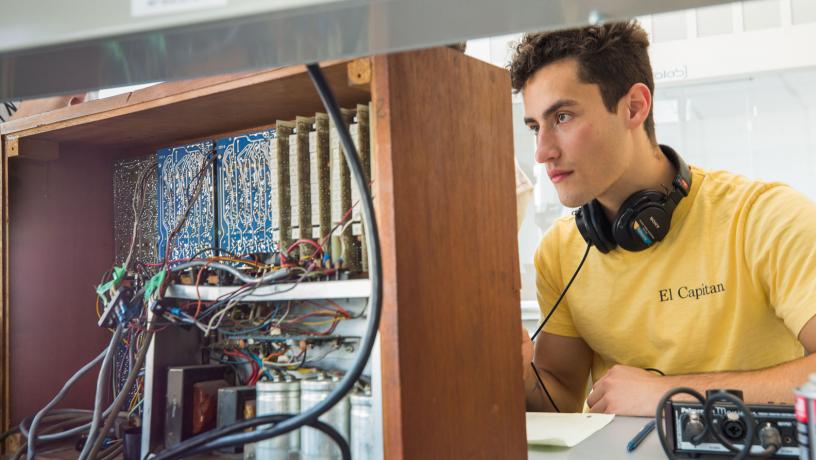
Fernando Pascual, a senior studying mechanical engineering, in front of a 100 series Buchla synthesizer cabinet.
“In any discipline, whether it be engineering or music or whatever, history is very important,” says William Mauro, a senior majoring in electrical engineering who’s part of the restoration team. “Because you need to know where things have been in order to know where they are going.”
Powered by some of the same types of analog technology that first flew us to the moon, Buchla’s synthesizer embodied a similarly pioneering spirit, a visionary aesthetic that helped chart the trajectory of modern popular music.
An avant-garde musician and composer who also sometimes worked for NASA, Buchla viewed art and technology as inseparable, and his inventions helped define what electronic music could be. Working at the same time as his more famous counterpart Robert Moog, the engineer designed not only one of the first synthesizers of its kind but also the first music sequencer, a wildly influential component capable of automatically repeating a set pattern of notes. As such, Buchla’s earliest creations are prized commodities—the Library of Congress currently owns one, and the Smithsonian reportedly tried to acquire the one belonging to Mills College. Columbia’s particular specimen holds layers of historical resonance—in the 1960s, CMC gave Buchla’s nascent company a boost by commissioning three of his seminal instruments; comprised partly from modules from that order, some of this synthesizer’s components were most likely soldered together by the inventor himself.
“There’s really no room for error in a timeless machine like this,” says student restorer Dani Dobkin, a PhD candidate in music. “We want to make sure that we do everything very precisely and very accurately.”
There’s really no room for error in a timeless machine like this. We want to make sure that we do everything very precisely and very accurately.
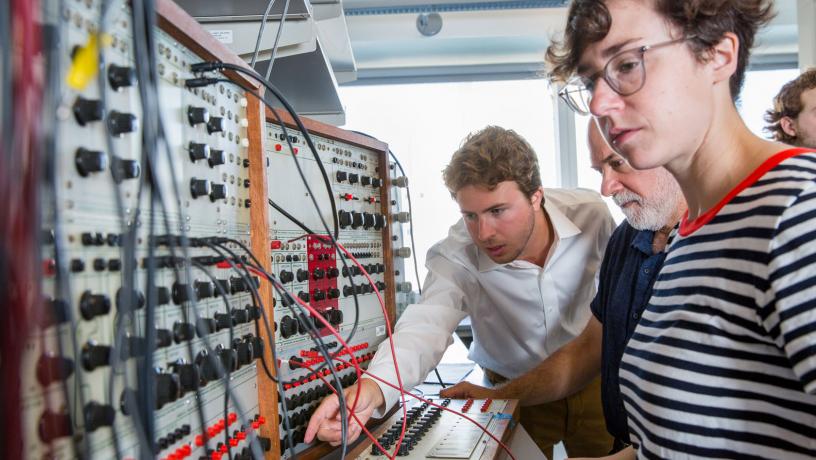
Student restorers William Mauro and Dani Dobkin with faculty adviser David Vallancourt.
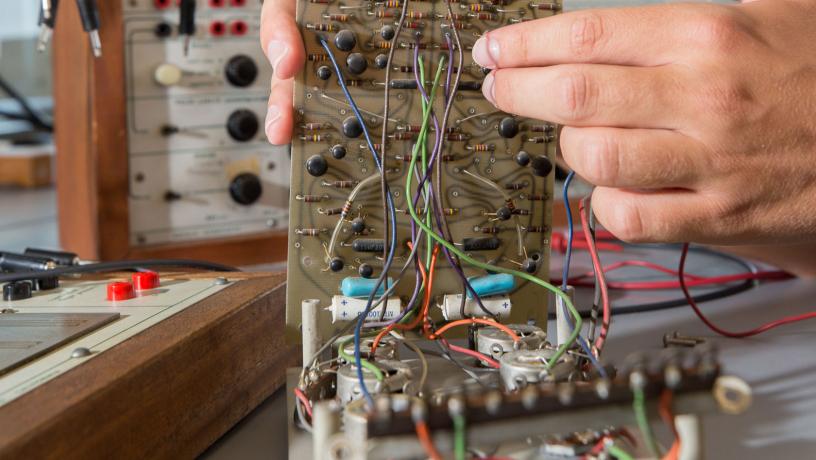
The synthesizer incorporates modules from different iterations of the series.
The restoration project was sparked when Dobkin approached CMC director Brad Garton about her hopes to bring the Buchla back into service. Garton had previously reached to Electrical Engineering Senior Lecturer David Vallancourt about possible collaborations; the latter quickly assembled an interdisciplinary team with the necessary skills. Along with Mauro and Dobkin, that team includes Luis Collado, a junior studying electrical engineering; James Kolsby, a senior majoring in computer science; and Fernando Pascual, a senior in the mechanical engineering department. Vallancourt currently serves as the group’s faculty adviser.
Last fall, the students launched the restoration by methodically assessing the damage.
“Because it uses transistors, we could rely more on mechanical pieces not having failed,” says Collado.
But many elements had degraded significantly. Over the course of six decades, fuses had blown (or gone missing), components slipped out of specification, knobs got clogged with dust, and power supplies transformed into a tangle of misplaced wires and unlabeled rail voltages.
Two semesters later, two of the synthesizer’s three cabinets have refound their voices, with an historically appropriate updating to the power supply being the last remaining technical hurdle. “Switch-mode power supplies, which are the most common variety today, can impose noise on analog equipment like a synthesizer,” Mauro notes. “We’re currently tracking down a suitable linear power supply, which is in keeping with what was originally used in the Buchla.”
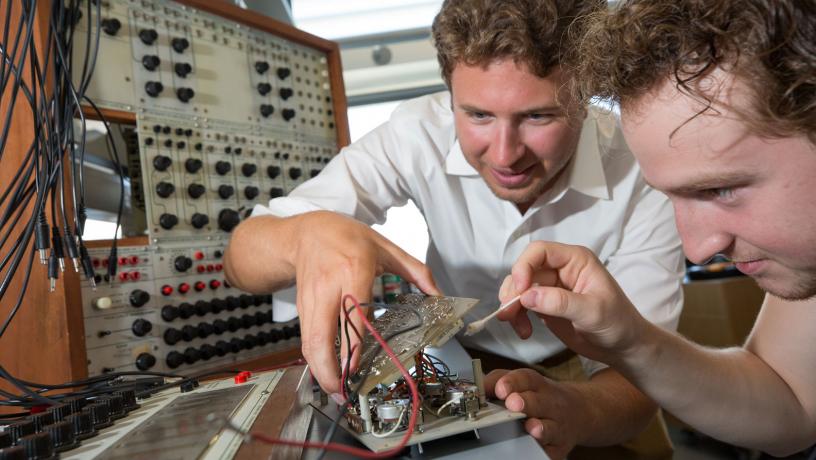
Mauro and computer science major James Kolsby cleaning knobs.

Electrical engineering student Luis Collado picked up conservation techniques while working in an instrument repair shop.
Other replacement parts are proving more difficult to find, such as the telephone switchboard indicator lights needed to illuminate the sequencer. Faithful restoration means bringing careful attention to questions of style and substance. Hailing from the days of predigital computing, the machine was produced at a time when transistors and solid-state technology were new concepts. As such, it functions as a prime example of how technology evolved through the era when vacuum tubes were slowly leaving the scene, and in its inner workings, it’s possible to trace back what transistors were on their way to becoming. “Its design is all circuits,” says Pascual, “and it represents a huge stepping stone for making synthesizer circuits more compact.”
It would be very hard to find another place with that deep a connection to electronic music. That’s about being at Columbia and about being in New York City.
Pulling original schematics off the internet is one method for ensuring the students are returning the synthesizer to its former glory without running the risk of modernizing it. “We often try to put ourselves into the shoes of someone from that era,” Collado says. “It’s a lot of historical orienting of our mind-set to the point of view of a 1963 innovator of music, who was building this when it was revolutionary.”
And Buchla’s was a very particular mind-set. Believing that electronic music was an inherently different kind of music led him to engineer some novel bits of machinery. For instance, rather than a conventional keyboard, his synthesizer sports a metal touch plate that contains no set notes. In looking for a way to circumvent the “limitations” of the musical scale, he ended up devising an early example of now ubiquitous touch technology.
“It’s just an incredible opportunity to get to work on something so historically significant,” Kolsby says. “One of the most interesting things for me academically is the design of the instrument’s interface. The way in which Buchla wanted us to interact with his instrument is presented very clearly through the way the modules are arranged and designed...but at the same time he’s left so much room for self-expression.”
Though Dobkin is the only group member officially studying music, Mauro is a keyboardist experienced with vintage and modern synthesizers, while Kolsby and Pascual—who perform together in a band—play both keyboards and guitar. Collado, a guitarist, put to use techniques gleaned from a stint working in an instrument repair shop in restoring the synthesizer’s knobs.

The synthesizer contains components originally soldered together by inventor Don Buchla himself. The various modules had to be individually cleaned and restored.
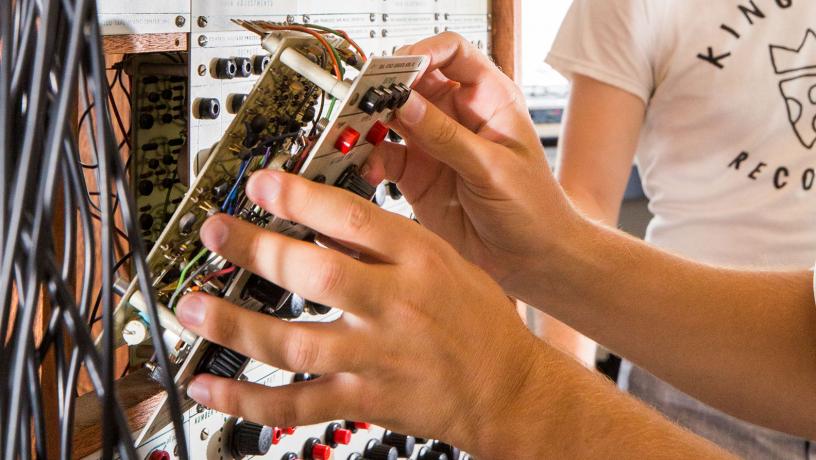
Once the restoration is complete, the group will conduct a full circuit analysis.
In general, crossover between the two disciplines is so common that the Department of Music offers a list of course recommendations for music-loving engineers, including a handful that satisfy requirements for technical credit. At Columbia, that’s a tradition that runs especially deep—before Moog helped lay the groundwork for a musical revolution, he earned his bachelor’s in electrical engineering on campus in 1957. Founded in 1958, CMC is currently the country’s oldest operating center of its kind, and Garton sees in the Buchla project a model for future collaborations between the center and Columbia Engineering.
“It would be very hard to find another place with that deep a connection to electronic music,” says Vallencourt. “That’s about being at Columbia and about being in New York City.”
As the first phase of their restoration nears its end, the students have already set their sights beyond simply recovering the Buchla’s sound. Once the synthesizer is fully functional, the group next plans to conduct a complete circuit analysis— capturing never-before-collected data that will offer new insights on a remarkable relic.
“A lot of great projects get off the ground because of ideas brought in by the students,” Vallancourt says. “That’s what happens when you’ve got students of this quality showing up here.”
